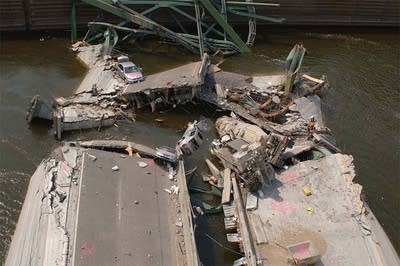Report gives Minneapolis high marks on bridge collapse
Go Deeper.
Create an account or log in to save stories.
Like this?
Thanks for liking this story! We have added it to a list of your favorite stories.

A new federal report gives Minneapolis generally high marks for its response to the Interstate 35W bridge collapse, but finds room for improvement as well.
The report released Tuesday by the U.S. Fire Administration said most of the concerns had already been recognized and addressed by the city, but that they were worth discussing so other communities can learn from the Aug. 1 disaster, which killed 13 people and injured 145.
"The city's ability to respond had evolved over several years of investing heavily and widely in all the elements that make a crucial difference when disaster strikes," the federal agency said in a statement.
The U.S. Fire Administration, a branch of the Federal Emergency Management Agency, works to reduce the loss of life and economic losses caused by fires and related emergencies.
Turn Up Your Support
MPR News helps you turn down the noise and build shared understanding. Turn up your support for this public resource and keep trusted journalism accessible to all.
Kristi Rollwagen, the city's deputy director of emergency preparedness, said she was pleased with the report and proud of the city's response.
"I take the constructive criticism to heart," she said.
Among the problems cited in the report:
- The Fire and Police Departments did not start with one unified command post at the scene. They kept in close radio communications, but a single post wasn't established until rescue operations were over. Because of that, emergency medical services didn't have a single point of contact.
- The city's emergency operations center wasn't big enough to manage such a major event, though it operated safely and effectively anyway.
- There was no formal safety officer to monitor the safety of first responders, and many police and medics did not follow an order to evacuate the bridge when instability was suspected.
- There was confusion for the first several hours over which agency was in charge of the Family Assistance Center, though it also said the families of the missing and dead were supported well.
On the positive side, the report said:
- Cooperation among the agencies involved was outstanding. "Strong working relationships and knowledge of roles and procedures were arguably the greatest strengths of the Minneapolis emergency services community's response. ... Key players not only knew each other, but were familiar with the operations and disaster assignments of others. When it came time to pull together efficiently as a team they did."
- Local officials had taken FEMA's Integrated Emergency Management course, which they credited as a major factor in raising their level of preparedness.
- The city's new 800 megahertz radio system streamlined communications and ensured that a variety of organizations could communicate with each other.
- Every patient who survived the collapse and was taken to a hospital survived. The one person who was pronounced dead at a hospital suffered a cardiac arrest at the scene and had little or no chance.
Rollwagen said the FEMA course mentioned in the report was crucial. She said local officials came back from it with a long list of things they needed to fix, and invested a lot of resources in doing that.
Another key point noted in the report, she said, was the importance of the good working relationships among all the local, state and federal emergency agencies involved.
"We found out that night that having those relationships was absolutely paramount to our success. We couldn't have done it without our partners," Rollwagen said.
(Copyright 2008 by The Associated Press. All Rights Reserved.)



